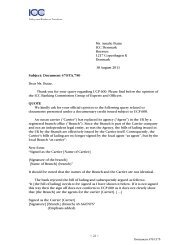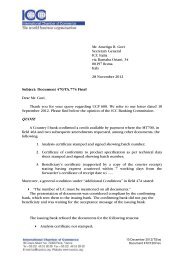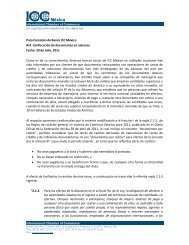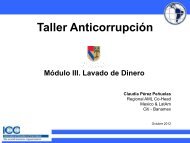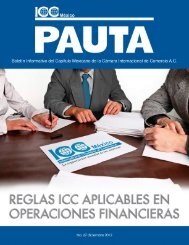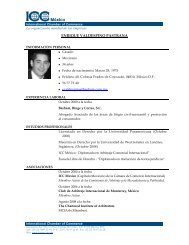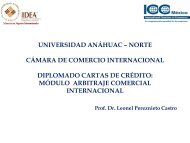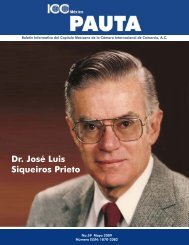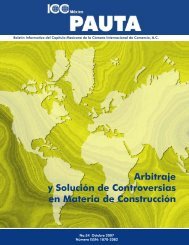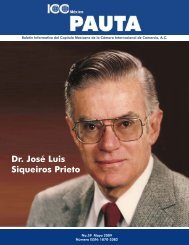Pauta 32.pdf - ICC México
Pauta 32.pdf - ICC México
Pauta 32.pdf - ICC México
- No tags were found...
Create successful ePaper yourself
Turn your PDF publications into a flip-book with our unique Google optimized e-Paper software.
REVISTA PAUTA No. 32Our purpose is not to craft one law for all, or to establish a single, central authority with exclusive power todecide how that law is made or changed. Harmonised law is the fruit of common goals, shared initiatives, thefree movement of legal models and the concerted choice of the best possible solutions. The State and thebusiness community are the prime actors and beneficiaries in the harmonisation process and they will beseeking appropriate solutions to perceived needs in an efficient and cost-effective manner. But the law-makingprocess is also fuelled by bodies specialising in the harmonisation of substantive law or conflict rules. Amongthese bodies, at world level, are the Hague Conference of Private International Law, the United NationsCommission for International Commercial Law (UNCITRAL) and the International Institute for theUnification of Private Law (UNIDROIT) take pride of place, while at the regional level, the work of the Inter-American Specialised Conferences on Private International Law (CIDIP) of the Organization of AmericanStates and that of other ad hoc bodies set up in the framework of regional integration organisations such asNAFTA are good examples.Legal harmonisation tends to be undertaken in response to a need – or because it is regarded as opportune – toresolve the differences between legal systems, or because the advantages of ironing out existing divergences andimplementing uniform rules are self-evident. As a rule this need is brought to light by economic and comparativelaw studies, together with proposals for possible solutions. From this point of view, the method most likely tomeet with success is that which relies on functional equivalence: rules drafted to serve a clearly defined purposethat obeys the domestic law of States but steers clear of any conceptual references which might stand in the wayof harmonisation.Legal harmonisation requires a variety of skills, but the first imperative is a meeting of minds. Legal scholarstoday face a whole new set of responsibilities: they must of course know the domestic law, but they should alsobe able to “think beyond” its models and instruments to seek solutions of a more international scope.A whole panoply of legal instruments was brought into play to produce the great upsurge in the creation of newrules in the second half of the XX th century. In addition to international conventions and model laws, we nowhave principles, guides, recommendations, and other instruments that vary widely in number, form, objectivesand indeed method of implementation. Such texts are drafted on the initiative of States by specialised bodies, thecompetent inter-governmental organisations, and once they have been adopted little more is generally said as totheir usefulness or technical qualities. Yet they by no means all share the same fate. Bureaucratic inertia notseldom thwarts the acceptance process, and many is the convention that never obtains the requisite number ofratifications for it to enter into force. Often, governments wait for other countries to make their positions knownbefore deciding on their own course of action. And even when all is well and the Convention’s rules have becomepart of a State’s domestic law, the potential users – and even judges and arbitrators – are not always very welldocumented as to their existence, the way in which they function and the advantages that might accrue.It is important to give thought to why this is so, and what can be done to remedy the situation. A crucial point isthat these instruments are implemented in such a way as not to undo the efforts and resources deployed withinthe international fora to produce quality texts suited to the users’ needs. Clearly, harmonisation of commerciallaw focuses on practical needs and must show tangible advantages by reducing the cost of commercial operations.Those who use legal instruments must first and foremost be convinced of the usefulness of uniform lawinstruments and be able to put them to best advantage. However, it would be detrimental if the unification ofcommercial law heeded only such criteria as business profit and neglected values deeply rooted in the cultural andlegal tradition that reflects the beliefs or philosophy of the community it is intended to serve, such as thoseenshrined in the rules of civil procedure or some of the guiding principles of contract law. It is worthremembering in this context that one of the most ambitious harmonisation projects in this sphere, the UNIDROITPrinciples of International Commercial Contracts prepared under the auspices of UNIDROIT, has been so successfulprecisely because it is not binding, because it employs a flexible “restatement” formula, Anglo-Saxon style, whichrelies on the voluntary choice by the parties – or by the courts – of the rules it proposes.Mexico’s participation in international negotiations to prepare uniform private law instruments, and the exchangeof experience gained by members of the legal and business world concerned have provided convincing evidenceof the importance of a systematic approach geared to facilitating the interchange between international andnational bodies.33



